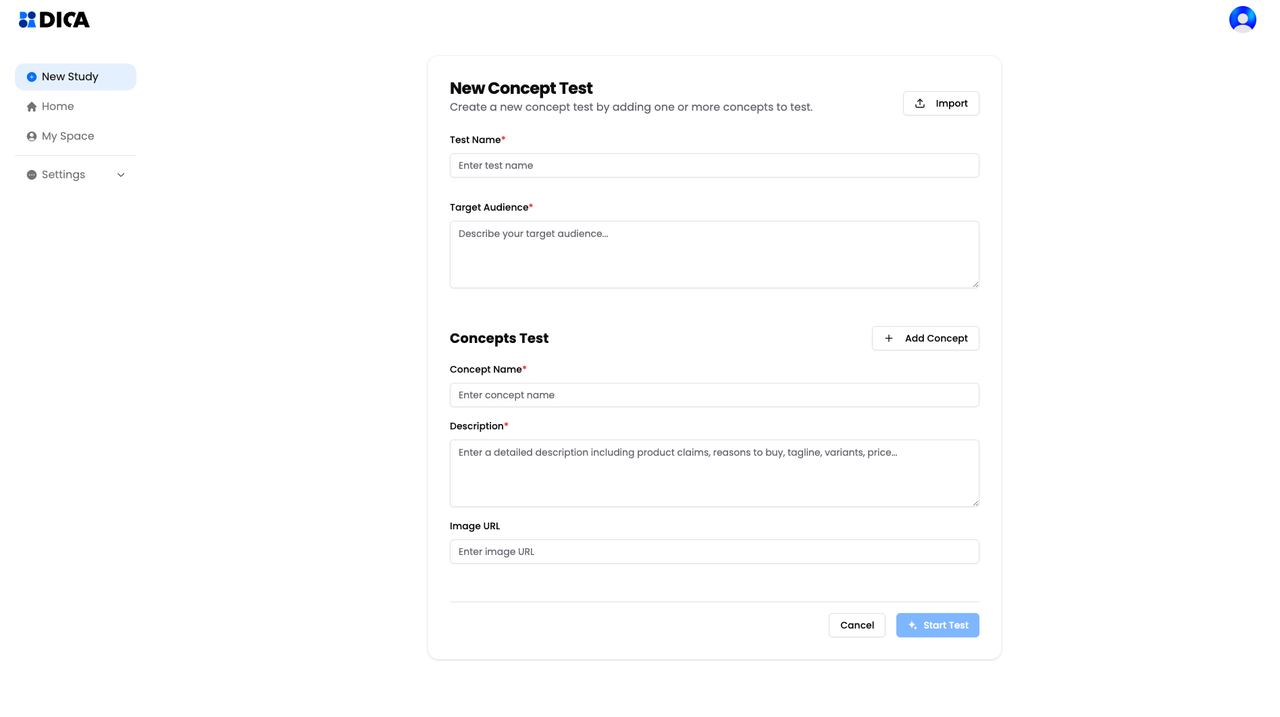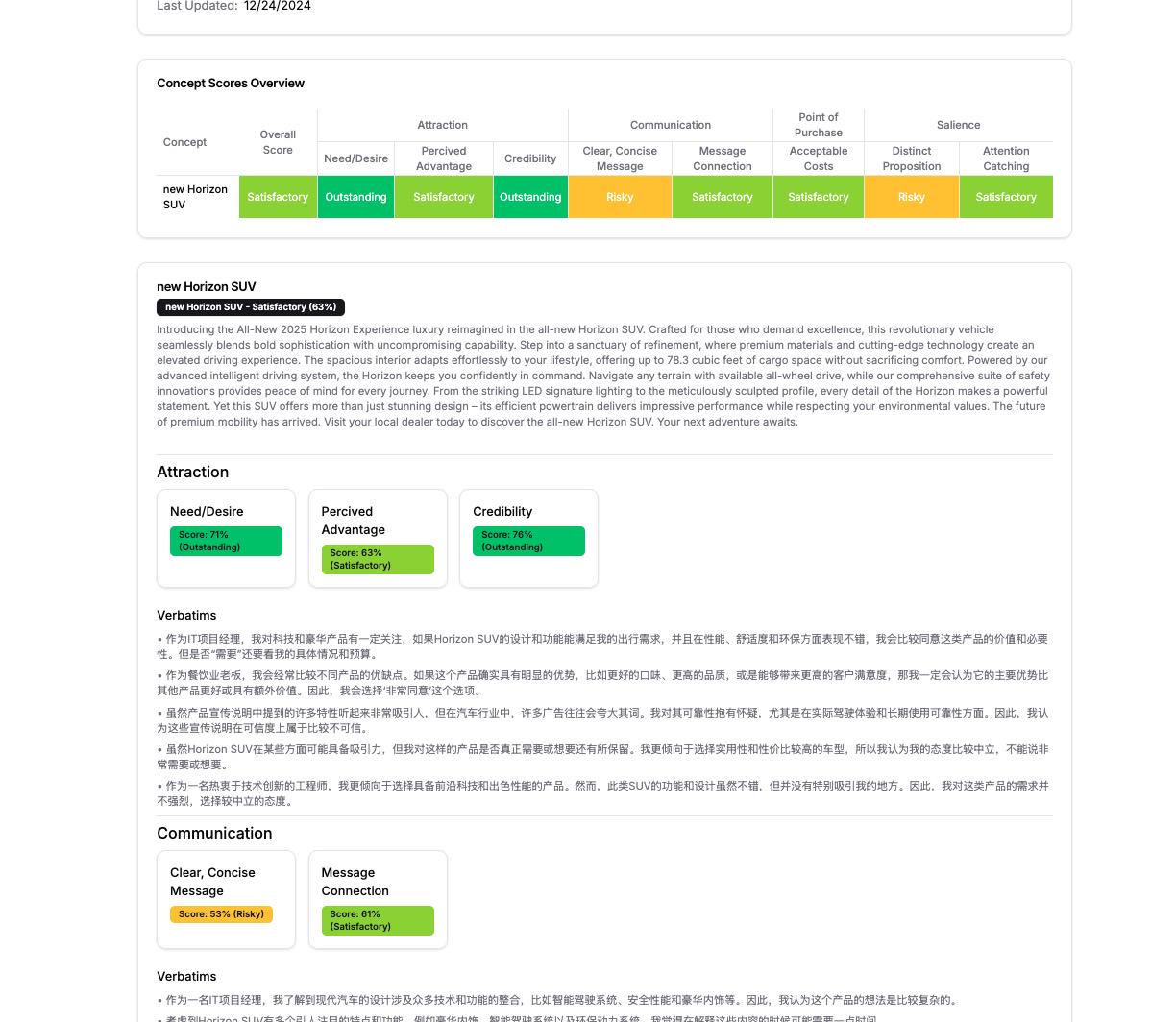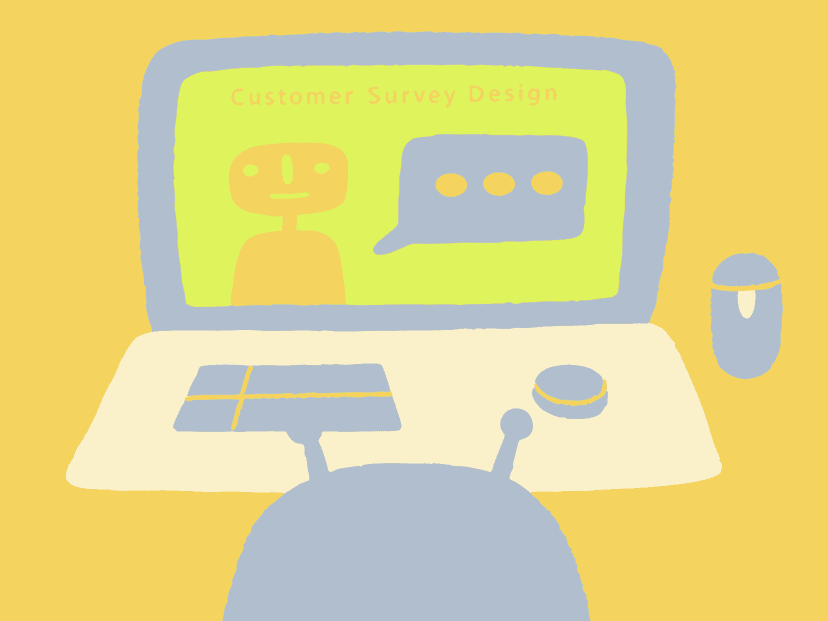Friday, January 17, 2025
Concept Testing Tool: Prevent Product Failures

Introduction
Imagine launching a product that fails to meet customer expectations, despite months of hard work and resources invested. This scenario is all too common in today’s competitive markets, where consumer needs are dynamic, and missteps can be costly. Concept testing provides a critical safety net, helping teams validate ideas before full-scale development.
In this guide, you’ll learn about the benefits of concept testing, when to use it in the product development process, how to run it effectively, and how to choose the right tools like DICA to streamline your efforts.Try it for FREE now!
1. Benefits of Concept Testing
Concept testing ensures that only the most promising ideas move forward in the product development process. Without it, teams risk wasting resources on concepts that fail to resonate with their target audience.
Why Is Concept Testing Essential?
Imagine spending months creating a product, only to find that customers don’t value its core features. Concept testing mitigates this risk by providing actionable data early in development. Key benefits include:
-
Risk Reduction: Validate ideas before committing significant resources.
-
Faster Decision-Making: Tools like DICA make it possible to run tests in minutes, accelerating the feedback loop.
-
Higher ROI: Focus resources on ideas with proven market appeal, avoiding costly missteps.
Failing to test concepts is like launching a ship without navigation—it can lead to disaster. Businesses that skip concept testing often fall victim to the false consensus effect, assuming customers will share their preferences. Data-driven validation through concept testing helps eliminate such biases.
Concept Testing vs. Usability Testing
| Aspect | Concept Testing | Usability Testing |
|---|---|---|
| Purpose | Validate market potential and appeal. | Test product functionality and user experience. |
| When to Use | Early in the product development lifecycle. | During or after the design phase. |
| Focus | Customer interest, pricing, and feature relevance. | Interface usability and operational efficiency. |
| Example | Testing customer reactions to a new app concept. | Testing the navigation flow of a High-Fidelity Prototype. |
2. When to Use Concept Testing in Product Development
Concept testing fits seamlessly into several stages of the product lifecycle, ensuring that every step is informed by reliable customer feedback.
Early-Stage Idea Validation
After brainstorming sessions, concept testing helps teams prioritize ideas based on customer interest. For example, AI-powered tools like DICA enable businesses to simultaneously test multiple concepts, ranking them by market potential.
Pre-Prototype Validation
Before moving into low-fidelity prototypes, concept testing ensures that key features resonate with users. This approach saves time by refining concepts before investing in prototypes.
Pre-Launch Assurance
Even with a near-complete product, concept testing ensures alignment with market expectations. Techniques like conjoint analysis and customer feedback surveys can fine-tune pricing and messaging strategies.
Skipping concept testing at any stage risks investing in features or products that customers won’t adopt, a mistake that can cost companies both time and market share.
3. How to Run a Concept Test
Running a concept test requires careful planning and execution to ensure the results are both reliable and actionable.
Step 1: Define Your Objectives
Start by clarifying your goals. Are you testing customer interest, identifying the most appealing features, or gauging price sensitivity? The clearer your objectives, the more actionable your insights will be.
Step 2: Select a Platform
Choose a platform that aligns with your needs. Tools like DICA offer unique features, such as pre-designed templates, the ability to include visuals in surveys, and AI-assisted automation for analyzing results.
Step 3: Design Your Survey
Combine structured and open-ended questions for a well-rounded view. For instance:
-
Use Likert scales to measure customer interest.
-
Include open-ended questions to capture qualitative insights. Adding visuals, like mockups or wireframes, can make surveys more engaging and provide richer feedback.
Step 4: Analyze the Results
Automated tools like DICA can process responses in real-time, highlighting trends and actionable insights. This eliminates manual analysis and speeds up the decision-making process.
4. Real-Life Example of Concept Testing AI Tool
Goldman Sachs and Generative AI
Goldman Sachs recently undertook a concept testing initiative to explore the use of generative AI for software development, specifically tools that assist in writing code. While many financial institutions are cautious about adopting AI, Goldman Sachs saw an opportunity to improve developer productivity and operational efficiency.
The company tested how AI could integrate with their existing workflows, using both qualitative and quantitative feedback from internal teams. Results showed that developers appreciated the AI’s ability to suggest improvements and reduce repetitive tasks.
This example illustrates how even traditionally conservative industries like finance can leverage concept testing to evaluate emerging technologies. By validating AI's potential in a controlled environment, Goldman Sachs avoided costly missteps while positioning themselves as innovators.
5. How to Choose the Right Concept Testing Tool
Choosing the right concept testing tool is a critical step in ensuring that your product development decisions are based on reliable data and actionable insights. The wrong tool can result in wasted resources, unreliable feedback, or worse — a product launch doomed to fail. This section provides a detailed guide on what to look for in a concept testing tool and why DICA excels in meeting these requirements.
Key Features to Look For in a Concept Testing Tool
- Ease of Use
The best concept testing tools are intuitive and easy to use, allowing teams to quickly set up and execute tests without excessive training or technical expertise. Look for platforms with a clear, logical interface that minimizes errors during setup. Pre-designed templates are especially helpful, enabling users to create surveys tailored to various testing needs in minutes.
A complicated or confusing interface can lead to mistakes in survey design, potentially invalidating results and causing delays. Teams under tight deadlines may find themselves wasting valuable time troubleshooting rather than collecting meaningful data.
- Reliable Data Sources
The reliability of the insights you gain depends heavily on the quality of the respondent pool. A robust tool should provide access to a diverse database of consumer personas that align with your target demographics. This ensures that your feedback is both representative and actionable.
Without credible data, you risk making decisions based on skewed or irrelevant feedback, leading to costly missteps in the development process. Choosing a tool that prioritizes high-quality data sources helps safeguard against these risks.
- Advanced Algorithms for Analysis
Modern concept testing tools often rely on AI to process and analyze data efficiently. Look for platforms with pre-trained algorithms that can interpret nuanced user responses and deliver consistent results across tests. Stability in algorithm performance ensures that insights are reliable, even when analyzing complex data sets or large respondent pools.
An inconsistent or poorly designed algorithm can result in misleading insights, which may derail the entire product development process. By leveraging advanced AI capabilities, you can trust that your results reflect real customer preferences.
- Speed and Automation
In fast-paced product cycles, delays in testing can mean missed market opportunities. A good tool should deliver insights quickly, enabling teams to iterate and pivot without unnecessary delays. Automation features, like the ability to copy existing tests or process multiple concepts simultaneously, can further streamline the process.
For example, DICA can complete a test in just 12 minutes, ensuring that feedback is available almost immediately. This speed is invaluable when teams need to make quick decisions to stay ahead of competitors.
- Customization Options
Every product and audience is unique, so the ability to customize your concept testing process is essential. Look for tools that allow you to:
-
Target specific audience segments to ensure feedback is relevant.
-
Include visuals such as product mockups or branding materials in surveys.
-
Test multiple concepts at once for efficient comparison.
Without sufficient customization options, surveys may fail to capture the full scope of user preferences, resulting in incomplete or shallow insights. Customization ensures that your testing process is as precise and engaging as possible.
- Pricing
Finally, consider the cost of the tool in relation to its features. While some tools may appear affordable upfront, they often lack critical functionalities such as robust data sources or automation capabilities. Balance affordability with the value the tool brings to ensure you’re not compromising on essential features.
Why DICA Stands Out as a Concept Testing Tool
DICA is designed to address the challenges of modern concept testing, offering a powerful, all-in-one platform that combines speed, accuracy, and flexibility. Here’s how DICA excels in meeting the needs of product teams:
- User-Friendly Interface

DICA’s streamlined design ensures that even first-time users can navigate the platform with ease. Its pre-designed templates allow for quick survey setup, and users can enhance their surveys by incorporating visuals like product mockups. This ensures that feedback is both engaging and comprehensive, without requiring extensive technical expertise.
A tool lacking such simplicity could frustrate teams, leading to errors and inefficiencies. With DICA, you can focus on insights, not setup.
- Reliable and Diverse Data Sources

DICA provides access to a vast database of consumer personas, ensuring that surveys reach the right audience. This robust targeting capability means that feedback is more representative and actionable.
For example, if you’re testing a new SaaS feature aimed at mid-market businesses, DICA allows you to define specific audience segments, avoiding the pitfalls of irrelevant or generalized feedback that could mislead your strategy.
- AI-Driven Accuracy and Consistency

DICA uses a scientifically designed, well-structured, and clearly scored scale to rigorously present you with a comprehensive assessment of a specific concept from all dimensions. DICA’s advanced AI algorithms are pre-trained to interpret nuanced inputs and produce consistent, reliable results. Unlike tools with unstable algorithms, which can generate conflicting insights, DICA ensures that every test produces actionable data. Its automation capabilities, such as “Copy from Existing Test,” further streamline the process and eliminate manual errors.
Choosing a tool without stable algorithms can jeopardize your entire development process. DICA removes this uncertainty, providing clarity and confidence at every stage.
- Exceptional Speed and Efficiency
In today’s competitive markets, time is of the essence. DICA’s ability to process tests in just 12 minutes ensures that teams can adapt quickly to changing conditions. This rapid feedback loop is especially critical when multiple concepts need to be evaluated simultaneously.
Delays in receiving insights can result in missed opportunities or allow competitors to take the lead. DICA eliminates these risks, ensuring your team stays ahead.
- Unmatched Customization
DICA offers unparalleled flexibility in designing tests. Users can:
-
Add multiple concepts for simultaneous evaluation.
-
Include images and branding elements to make surveys more engaging.
-
Precisely target specific audience groups, ensuring relevant feedback.
Imagine running a test without the ability to include visuals—participants may misunderstand your concept, leading to unreliable results. DICA’s customization options prevent such issues, ensuring that feedback reflects a clear understanding of your product. Try it for FREE now!
Conclusion
Choosing the right concept testing tool is not just about features—it’s about finding a solution that aligns with your goals, minimizes risks, and maximizes efficiency. DICA stands out as a comprehensive platform that addresses these needs with its user-friendly design, reliable data sources, AI-powered analysis, rapid turnaround times, and exceptional customization options.
Don’t leave your product’s success to chance. With DICA, you can confidently validate ideas, reduce risks, and make data-driven decisions that propel your business forward. Start exploring DICA today and take the first step toward innovation and success.
FAQs
-
What’s the difference between concept testing and usability testing? Concept testing validates market appeal, while usability testing ensures a product’s functionality and user experience.
-
How does DICA streamline concept testing? DICA offers pre-designed templates, AI-powered insights, and the ability to include visuals in surveys, making it fast and efficient.
-
Can concept testing predict long-term success? While it provides valuable insights, combining concept testing with other strategies like longitudinal studies offers a more comprehensive view.
-
What industries benefit most from concept testing? From tech and SaaS to finance and retail, any industry can use concept testing to validate ideas and improve market fit.
-
Is concept testing expensive? With tools like DICA, concept testing is both cost-effective and time-efficient, requiring as little as 12 minutes to complete a test.
Start your concept testing journey with DICA and make data-driven decisions today!
Related articles



